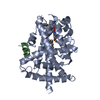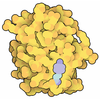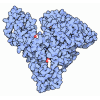Entry Database : PDB / ID : 6ijrTitle Human PPARgamma ligand binding domain complexed with SB1495 16 mer peptide from Nuclear receptor coactivator 1 Peroxisome proliferator-activated receptor gamma Keywords / / / / Function / homology Function Domain/homology Component
/ / / / / / / / / / / / / / / / / / / / / / / / / / / / / / / / / / / / / / / / / / / / / / / / / / / / / / / / / / / / / / / / / / / / / / / / / / / / / / / / / / / / / / / / / / / / / / / / / / / / / / / / / / / / / / / / / / / / / / / / / / / / / / / / / / / / / / / / / / / / / / / / / / / / / / / / / / / / / / / / / / Biological species Homo sapiens (human)Method / / / Resolution : 2.85 Å Authors Jang, J.Y. / Han, B.W. Journal : Sci Rep / Year : 2019Title : Structural basis for the inhibitory effects of a novel reversible covalent ligand on PPAR gamma phosphorylation.Authors : Jang, J.Y. / Kim, H. / Kim, H.J. / Suh, S.W. / Park, S.B. / Han, B.W. History Deposition Oct 11, 2018 Deposition site / Processing site Revision 1.0 Oct 16, 2019 Provider / Type Revision 1.1 Nov 22, 2023 Group / Database references / Refinement descriptionCategory chem_comp_atom / chem_comp_bond ... chem_comp_atom / chem_comp_bond / database_2 / pdbx_initial_refinement_model Item / _database_2.pdbx_database_accessionRevision 1.2 Oct 30, 2024 Group / Category / pdbx_modification_feature
Show all Show less
 Open data
Open data Basic information
Basic information Components
Components Keywords
Keywords Function and homology information
Function and homology information Homo sapiens (human)
Homo sapiens (human) X-RAY DIFFRACTION /
X-RAY DIFFRACTION /  SYNCHROTRON /
SYNCHROTRON /  MOLECULAR REPLACEMENT / Resolution: 2.85 Å
MOLECULAR REPLACEMENT / Resolution: 2.85 Å  Authors
Authors Citation
Citation Journal: Sci Rep / Year: 2019
Journal: Sci Rep / Year: 2019 Structure visualization
Structure visualization Molmil
Molmil Jmol/JSmol
Jmol/JSmol Downloads & links
Downloads & links Download
Download 6ijr.cif.gz
6ijr.cif.gz PDBx/mmCIF format
PDBx/mmCIF format pdb6ijr.ent.gz
pdb6ijr.ent.gz PDB format
PDB format 6ijr.json.gz
6ijr.json.gz PDBx/mmJSON format
PDBx/mmJSON format Other downloads
Other downloads https://data.pdbj.org/pub/pdb/validation_reports/ij/6ijr
https://data.pdbj.org/pub/pdb/validation_reports/ij/6ijr ftp://data.pdbj.org/pub/pdb/validation_reports/ij/6ijr
ftp://data.pdbj.org/pub/pdb/validation_reports/ij/6ijr


 Links
Links Assembly
Assembly


 Components
Components Homo sapiens (human) / Gene: PPARG, NR1C3 / Production host:
Homo sapiens (human) / Gene: PPARG, NR1C3 / Production host: 
 Homo sapiens (human) / References: UniProt: Q15788, histone acetyltransferase
Homo sapiens (human) / References: UniProt: Q15788, histone acetyltransferase X-RAY DIFFRACTION / Number of used crystals: 1
X-RAY DIFFRACTION / Number of used crystals: 1  Sample preparation
Sample preparation SYNCHROTRON / Site: PAL/PLS
SYNCHROTRON / Site: PAL/PLS  / Beamline: 7A (6B, 6C1) / Wavelength: 0.97933 Å
/ Beamline: 7A (6B, 6C1) / Wavelength: 0.97933 Å Processing
Processing MOLECULAR REPLACEMENT
MOLECULAR REPLACEMENT Movie
Movie Controller
Controller













 PDBj
PDBj













